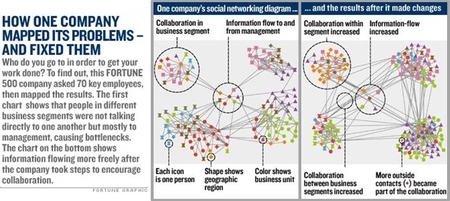Trainings and tools
Social network analysis
Variation: Organizational network analysis
What is social network analysis?
How to use network analysis: Mapping your organization
More Information
Examples
What is social network analysis?
Formal organization charts rarely reflect the way work actually happens in an organization. Instead, staff often work across units and divisions, with friends and colleagues that they know and like or who they've already worked with in the past.
By using Social Network Analysis (SNA), organizations can look for these existing connections, and tap them to make more effective teams that enjoy working together.
Think about the last time you needed help with an unfamiliar concept or piece of software: Did you go through your company's org chart to resolve your problem by talking to your supervisor, or did you call over to the person in the next cube for help?
SNA focuses on the relationships between actors, rather than an actor's attributes or characteristics as in other types of analysis. A person's attributes aren't comprised of his skills or knowledge in SNA--instead, we're concerned with who he knows and who he already works with.
You likely already use SNA to a degree, without realizing it: SNA looks for these informal connections within a community, and helps organizations understand how better to exploit them to achieve outcomes.
Click to view larger. Image source: CNN Money.com
How to use network analysis: Mapping your organization
Social Network Analysis is particularly useful within an organization experiencing material or informational bottlenecks, often because a single person holds the knowledge to contribute to a report or the authority to sign off on an action.
1. Survey your staff
Who do they regularly work with generally, or work with on a particular project? If they had to choose two or three people (and no more) on whom a particular project utterly depended, who would they choose?
2. Map staff connections
Map out connections using a pen and paper or software suited for SNA. Use arrows to indicate directions of dependency. You can also use different colors to indicate different attributes like employee type, work unit, or level of knowledge on a particular topic.
You'll likely find that work isn't occurring in a manner that's reflected by a traditional, hierarchical org chart. Instead, pockets of employees likely work together, across units and divisions, to achieve goals and outcomes:

Image: Orgnet.com: Managing the 21st Century Organization (PDF)
You can use this information to find bottlenecks in information or material flow, or silos where communication is completely absent but would be beneficial.
3. Find natural groupings, connections, and bottlenecks
After mapping existing networks of collaboration, you can find places to create redundancies to get around bottlenecks, or place closely connected individuals on an upcoming project team to maximize efficiency and collaboration.
More information
Social Network Analysis: A Brief Introduction
Orgnet.com
Introduction to Social Network Methods
Hanneman & Riddle
Informal Networks: The Company Behind the Chart
Krackhardt & Hanson
Examples of social network analysis
The Hidden Workplace
CNNMoney.com
Managing the 21st Century Organization (PDF)
Orgnet.com
The Spread of Obesity in a Large Social Network over 32 Years
Christakis & Fowler
